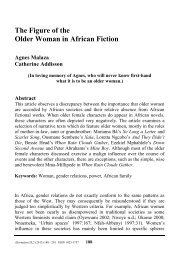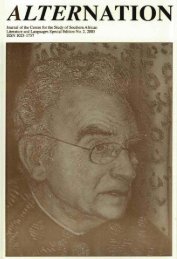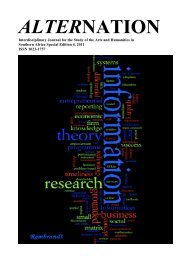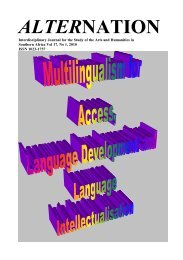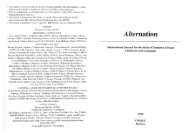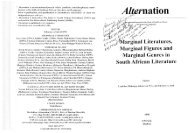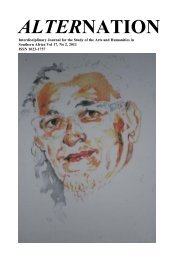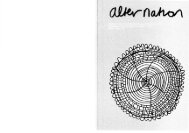Shane Moran - Alternation Journal
Shane Moran - Alternation Journal
Shane Moran - Alternation Journal
You also want an ePaper? Increase the reach of your titles
YUMPU automatically turns print PDFs into web optimized ePapers that Google loves.
.- -. . . ,.- 2 r I,UIILLLUYL qj ,>(j/~~h Ajric~~n Ffj,st~q,<br />
rtin Legassick ancl C;avj/ Minkleji<br />
disjrllegration (after the 1930s) of a class of black sharecroppers in tile southwestelll<br />
7iansvaal He is a Samuel Smiles hero, a self-made man-brought down in the end by<br />
a~al-theid This trajectory is closely intertwined with the history, nature and production<br />
of white owned and worked land, and ultimately with the developlnent and<br />
enaoach*nent of white capitalist relations of production in agriculture. This is the<br />
narrative thrust of The Seed is Mirze, although it is simultaneously a narrative in whi<br />
Kas Maine and his productive wishes, strategies, entrapments and forms<br />
illde~elldence are lnapped in all their specifics of locality and change.<br />
in addition tllough, as Bundy has suggested, there is also a secolld story<br />
intelTwinedwith it and resting 011 the concern with the sharecropping fainily as a 'social<br />
's adolescent iiatiollhood' (Nasson 1996:3). It is a book larger than itself, a~nodel<br />
South African past, standing for that past. Its past moreover-in contrast to the<br />
or~n of social histoly-is consistent with the idea of reconciliation. This rests not<br />
a history of simple racial separation, exclusio~i and the repression of imagined<br />
e (and thus on forgetting) but also on a history of social assimilation, inclusion,<br />
osmosis', of 'paternalism and violence', of a shared, albeit uneven past of an<br />
able inter-racial ~nilieu':~. The message of the book is thus a~nbiguous as<br />
epresent ofreconciliation. On the one hand it has a past pretnised on areading<br />
ower relations and conflict that also involves social assimilation (within and<br />
the categories of race). Making that past visible makes the politics of<br />
entit>" (Bulld~ 19971366; drawing on Van Onselen 1996:9). Here is Bundy's<br />
description:<br />
Kas Maine lnay have been heroic in llis versatility as far~l~er. stock-breedel-.<br />
artisan. mechanic. tradcr. speculator. and traditional IleaIcr. Yet lmally readers<br />
will wince at his record as husband and father: flogging his daugllters,<br />
estranging his sons, tnargi~ialising his wives. What van Onselen makes<br />
possible is an understanding of how two sets of demands-economic<br />
viability and domestic pliability-colluded and collided (Bundy 1997:367).<br />
ation a much Inore deeply embedded historical project than is conducted by<br />
, for exa~nple. On the other hand, however, the book emphasises the dramatic<br />
ping impact of a colnplex rural class conflict and transition to agrarian capitalisln<br />
below'. These collflicts of class would be displaced and silenced if all-embracing<br />
ial definitions (as defined by apartheid and resistance to it, and assulned in the TRC<br />
course) were taken as the categories to be reconciled.<br />
areas are important in examining the production of academic histoly in<br />
uth Africa. The first relates to methodology: of how peasants (and Kas Maine) speak<br />
e book. The second relates to the ways that the empirical research is conlbinedwith<br />
It is in these intersections between productive structure and peasant agency, and<br />
between sharecropper and patriarch, that Van Onselen parts company with lnuch south<br />
African social history. The categories of 'history from below' and of subaltenl agency<br />
and experience as distinctive and 'autonomous' are problematised. The book details<br />
how relations of kinship and paternalism were painful and violent, but also intimate and<br />
searing in their interactions between different categol-ies of black and white people on<br />
the Highveld. This meant that experience was a 'painful .sl~nredexperience7, mutually<br />
deterlnining in Inany respects and that a South African identity, incl~lding racial id en ti^<br />
elne%ed out of a nexus of colnplex relations betwecn trust and betrayal, colnpassioll<br />
and humiliatioll, love and hatred. Thus Terry Ranger (1997:384) suggests that van<br />
retical analysis of social aid economic change. AS regards the first there is a<br />
ificant paradox. Kas Maine's memory and his feats of re~nelnbrance validate the<br />
ole book as a subaltern 'peasant' voice ofthe past and of history. Yet Maine's voice is<br />
t made in the book, and neither is his or others' remembrances made explicit<br />
memory. AS importantly, though, Kas Maine's memory and his voice is seen to<br />
emplify 'histoly living on in the mind' where he 'never once ceased to amaze with tile<br />
curacy, depth and extent of his insights into the social, political and ec~nolnic<br />
ctures that dominated the south-westem Transvaal' .<br />
This shows, by the way, a different sense in which the book can be taken as<br />
collciliatioll history. Colin Bundy (1997:369) has suggested that in its combinatioll of<br />
Onsele~l's biography cnables us to see that 'Kas lives most of his life as an<br />
.4fi-ikanerised black on the land ofAti-icanised whites'. Relatiollships between hnnels<br />
and sharecroppers are m~~cll more fully integrated than in the conventional<br />
l~istol~. 'rhere is little place, Inoreover, for simple racial stereotype when the<br />
oppressive landlosd in the book is black.<br />
The ma.jor new insights in The &Seed is Mine arc prilnnr-i]y those of content<br />
aro~lnd the shared and interconnected nature of rural experience, At the sa1-n~ tiune, Van<br />
Ollselcn (1996:vi-vii) argues that 'the field ha[s] barely given way to the factoly, the<br />
e research with analysis rooted in theoretical understanding of economic<br />
social change, The Seed is Mine has 'outstripped or transcended the eitherlor<br />
cturalists vs social historians] antinomies of the 1980s'. The evidence of memory<br />
en, 1l0t only tells the peasant or subaltern story but also that of structures, providing<br />
cans to 'transcend the eitherlor antinomies of the 1980s scholarship'. What is<br />
ling, however, is that this is done without an engagement of me1norY, without<br />
Peasant to the proletarian, and the patriarch to his family': these changes, in other<br />
~\~nrds, ale I-ece~it. Tliis effectively jnscrts a 'peasant's voice' onto t]le centre st<br />
llistoly of twentieth Century and apartheid South Africa. Revisiollism (including,<br />
al-g~1aI?ly, earlier work by Van Otlselen (1 976) admittedly on Rhodesia and not soutll<br />
Aeica) constructed the migrant ~ninewol-kel- as the central s~lhjject of racial and class<br />
divisioll of the society and its history. Now, for Val1 Onselen, it is rather the mutual<br />
ex~el-iences of the sllare~ropping peasant on the I-ligliveld that is the 'very gastric juice<br />
of So~ltll Afi-icanism' aiid which should he the model or social vangllard 01. c~outll<br />
~l~~ notions of Lcultnra[ osmosis' and of and violence are cirawn from tllc titles<br />
two prior van ~ ~ ~ arlicles ~ ~ (1990: l e 1992) n wliicll predate thc book anci discirss of its<br />
eoretical arid mctllodological ~lndcrpinnings. The notion of a reconciliationist IlistoI-Y is oLir<br />
owrl. and is colrtrasted to tllc growing representations presented in official versions aimed at<br />
achieving political as in the TRC, for example. The LcSlnS 'incsca~abie interracial<br />
is Nassonls (1 ')96:4) , talking about van Onseten's anaiysjs of sllasecrupping in<br />
distant decades w[lere Afrikarlers wcrc Africaniscd and Afi-ica~is Afriknnerised ~l~i.o~~g11<br />
proczsses ofsocial assirnilation.



